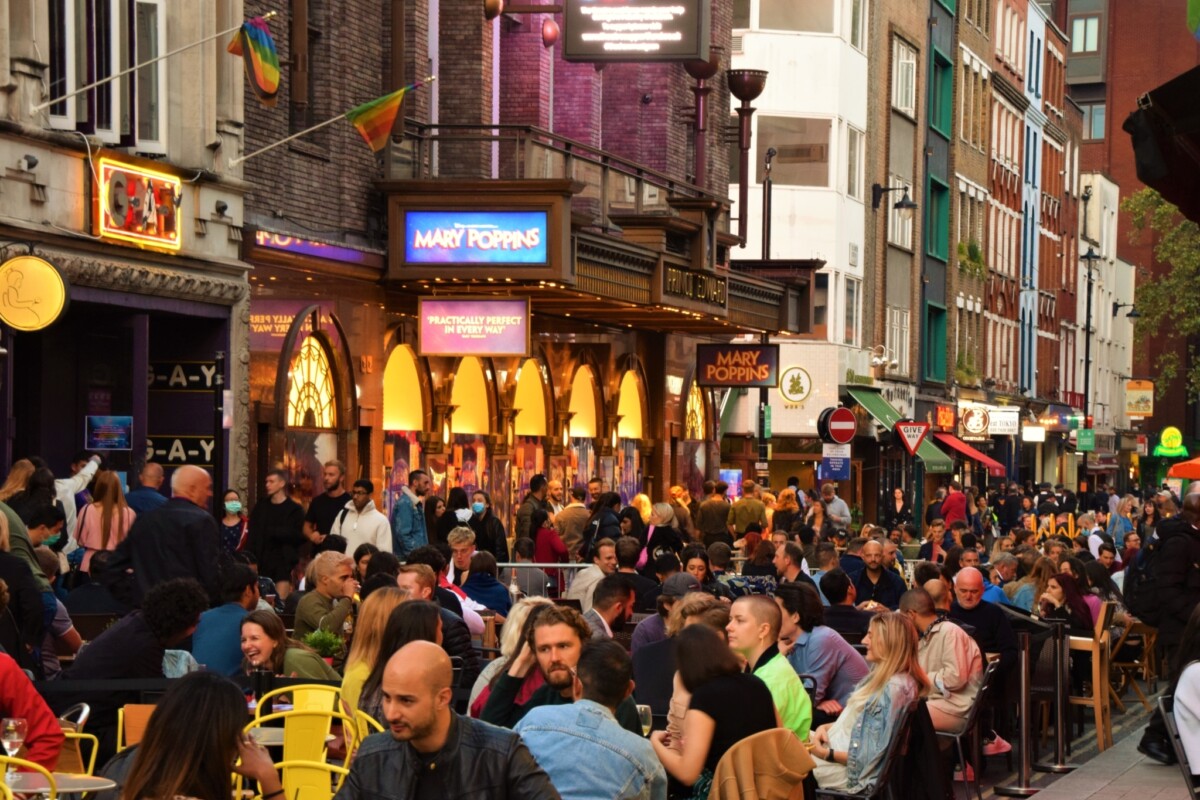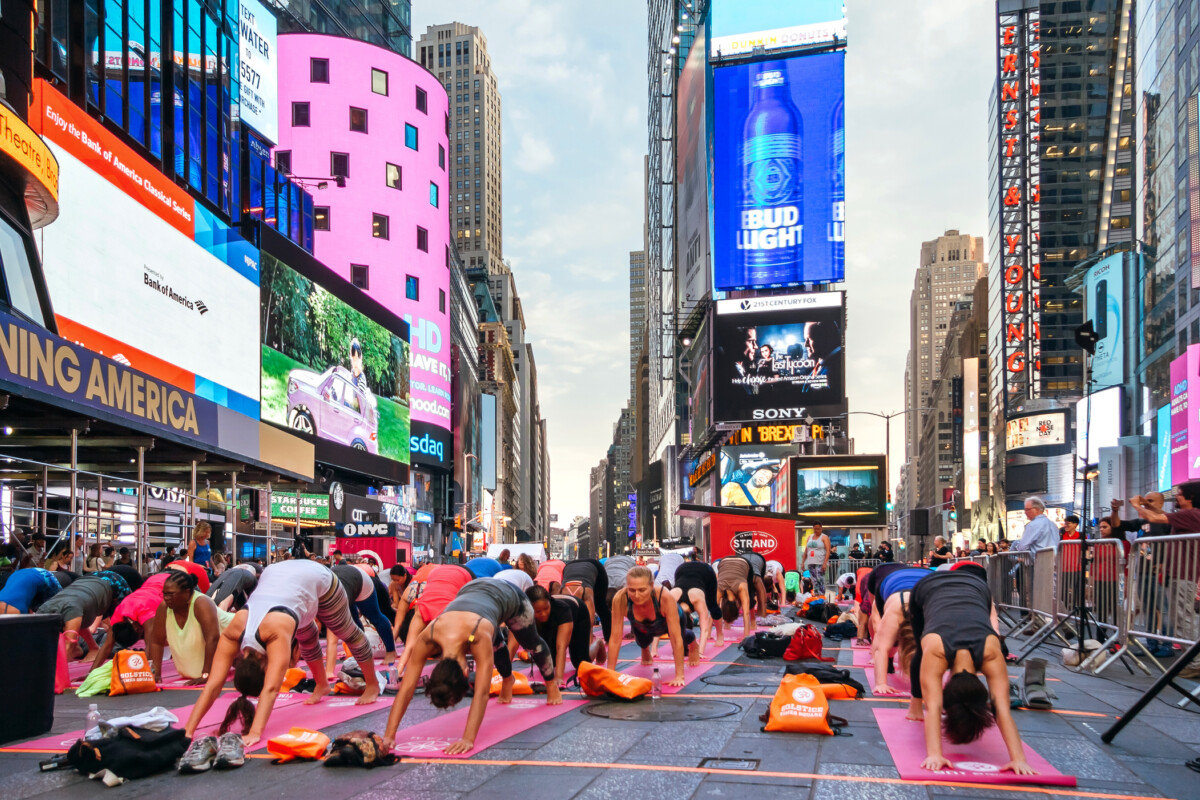
Understanding the customer: the need for more dynamic and nuanced analysis
Good urban design, particularly in an era of rapid and profound commercial and societal changes, must be underpinned by a thorough understanding of the people who will use, live, work, shop and enjoy the spaces we create, particularly if we are to reverse the phenomenon of identikit high streets and commercial centres that have plagued the UK and much of the western world in recent decades. The commonly understood segmentation of the post-war population into baby boomers, Generation X, Millennials and Generation Z has its uses and can help make sense of age-related societal shifts. However, as Director Marcelina Zielinska argues in this Insight paper, we need to move beyond this to gain a much better understanding of the complex drivers behind consumer/user behaviour if we are to create truly people-centred and sustainable urban centres.
The common approach to customer segmentation
When commencing designs for new urban regeneration projects, we firstly need to understand the profile of the people who will use the buildings and spaces we will create. It has been quite common in recent years, when reading or hearing about customer experience, for customers under the age of 75 to be broken down into four main groups: Baby boomers, Generation X, Generation Y (Millennials) and Generation Z. This categorisation is used to help businesses, urban planners, designers and developers figure out what differences in outlook, culture and habits there are between the generations, using that information as a broad guide to what range of offers will best cater for the needs and wants of each.
The broad observations usually applied to each group are as follows:
Baby boomers
The baby boomers were born between 1946-1964 and their upbringing was very different, compared with today. For example, their signature product was a black and white television and they were the first generation to use digital IT in their lives. Their main aspiration was job security and they tended to exhibit a respectful attitude. They looked to experts for advice, were generally very hard working and, today, they hold the reins of the economic power.
Generation X
Generation X, born between 1965-1980, experienced a social step-change compared to their parents, and their signature product was a personal computer. They tend to be more cynical, particularly as a result of the evolution of popular culture since the 1960s and the political crises of that period. While being more self-reliant, their main aspiration is to achieve a better work-life balance.
Generation Y / Millennials
Generation Y, born between 1981-1994 and commonly known as Millennials, have progressed to another level, with their signature product being a smartphone, on which they tend to spend a large proportion of time. They prioritise short-term experiences over long-term savings. Their main aspiration is for more freedom and flexibility and to be able to live their lives the way they wish. They are technologically adept and are very comfortable searching for, and purchasing, products online. They are perceived to be more laid back and value convenience, which has supported the rise of the likes of major food delivery apps, for example. Following the pandemic, it appears many of this generation are comfortable with the concept of working from home on a more regular basis.
Generation Z
Generation Z refers to those people born between 1995-2005. While it may be too early to accurately predict their preferences, we can be confident that the rate of change experienced during the previous generations will continue. In due course, their signature product might possibly be a driverless car and they will always be on the go, blurring their personal and professional lives. Their main aspiration might be security and stability, although they will want to be seen as individualistic and creative, standing out from the crowd. Their main influences will be gleaned from user-generated forums, being able to connect with many people around the world to gain the best insights on any subject. However, they are well-balanced and idealistic, with wellbeing, health and ecological sustainability very important to them.
The limitations of the four-generation approach
Dividing the post-war-born population into these generational groups has served a purpose, allowing retailers, designers, developers and others to grasp how attitudes and habits have changed over the past six or seven decades and to create strategies to target and attract one, some or all of them.
However, such broad generalisations are inherently problematic, for several reasons. Firstly, the whole concept of ascribing a single set of attitudes and habits to every person born between, for example, 1965 and 1980, is clearly too simplistic. Few people seriously expect that a set of people will share substantially identical characteristics and a worldview exclusive to their group purely because they were born in the same month or under the same astrological sign. Why would we similarly divide the post-war population into four large groups and expect substantial homogeneity within them?
Generations are obviously much more complex than that. Indeed, even using the term “generation” can lead to distortion. Isn’t it better viewed as a continuum with very vague boundaries? The person born just before midnight on 31 December 1964 will not automatically fall into a baby boomer mindset and the person born a few hours later on 1 January 1965 into a Generation X mindset!
Beyond that, we cannot make assumptions about people even born on the same day, in the same room or in the same family. We are all aware, for example, of the importance of environment and genetics in shaping the attitudes and needs of each one of us. We are also aware of how we are influenced by circumstances such as our place in the family birth order, our personalities often moulded by those of our brothers and sisters, if we have them.
Just to make the task even more complicated, we cannot even make assumptions about the same person on different days, at different times of the day, or as their life develops. People change! People are influenced by events, other people, environmental differences, etc. People may be morning-orientated or evening-orientated. And we know how major life or world events, such as the COVID-19 pandemic, can completely alter a person’s outlook, behaviour, values and preferences in a relatively short period of time.
A recent study by Cucina and colleagues found that, in a sample of more than 40,000 workers, there were no statistically significant differences in attitudes to work, for example. In fact, 98% of the variation occurred within the same generational groups, not between them.[i] Research has also shown that workers of all age groups broadly want similar things, such as flexibility and opportunities to broaden their skills.[ii]
The tedious truth for us, in trying to predict and cater for customer preferences, is that people are complex, often irrational and hard to predict. Therefore, we can see why the four-generation approach is a very blunt instrument which tends to force square pegs into round holes.
That’s not to say it is without its uses; it can still be helpful in a general way, particularly at early concept stages of projects – it embraces some basic truths and recognises that general shifts in behaviour do take place as we move across age groups. It is not overly complicated and it allows us not to become too bogged down in trying to figure people out in all their irrational glory. We just need to ensure that we do not over-rely on it and that we recognise its limitations. As we engage with data on a more granular level, we need to look at people and their behaviours in a much more nuanced manner, one which befits the complexity of our species.
Dynamic behavioural analysis
When we try to identify how we can design for people, whether it be for target markets or whole communities, we must recognise the importance of context to the decisions that people make. Instilling a sense of brand loyalty or a sense of belonging is contingent on more than just the fact that our users or customers belong to a certain demographic group; it’s also about how they perceive what we design or offer within a prism influenced by many factors, such as sustainability, ethical principles, aesthetic value, inclusivity, accessibility and relevance to their daily experience. The relative weighting of these factors will change from day to day, from hour to hour and from person to person, and we may often see no discernible correlation with the generation the person comes from.
By collecting much more detailed data and, most importantly, talking in depth to a representative selection of the relevant market, we can unpick how people arrive at their decisions and better cater for them. The more information we have, the better our own decision-making and the better the urban designs we create.
For example, we may find out that some people within a target demographic are more likely to eat out, go to the cinema or spend more on expensive goods at certain times of the week or month than others because they receive their pay on different days/weeks. Indeed, they may share their pattern of spending and socialising with others from different generations for the same reason. From this, we can identify patterns of use which can allow us to pre-empt behaviour and design spaces to flex according to when they are most or least in demand.
Alternatively, we may identify that parents are much more rushed and stressed if accompanied by their young children, affecting their decisions about whether to spend money and what to spend it on. They might make completely different decisions if by themselves and relaxed. From a design point of view, this might influence us to create a space for secure and enjoyable childcare, allowing the parents to take their time and enjoy the shopping or leisure experience.
This more nuanced approach allows us to create developments which are more socially and commercially robust and which respond intelligently to the complexity behind people’s decision-making. It doesn’t just assume what people are likely to do because of when they were born, it provides answers for why people make decisions and reveals a much more varied and interesting market as well as new opportunities.
It also better facilitates a process of personalisation, allowing retailers, designers, service providers and others to shape what they offer or create to the specific person, helping to foster a strong relationship and improving the chances of creating brand or place loyalty. This will be of particular importance as we look to provide more experience-led destinations, particularly in our high streets.
Adapting urban centres for different needs and outlooks
The COVID-19 pandemic has accelerated changes that were already under way in our high streets and commercial centres, and if we are to understand the rapidly changing environments in which we live and anticipate the consequences of all this change for our urban centres, we need to build as full a picture of who the customers or users are, rather than reducing them to caricatures.
There are many factors which should inform the design of our urban centres; when reviewing future proposals to align with customer requirements, we need to consider the following principles:
- We need to reintroduce authenticity into our centres to overcome the cloned town syndrome.
- The customer will demand that a sustainable approach to design is embraced.
- We need to reintroduce a mix of uses to underpin the creation of new communities for all ages.
- Our centres need to provide for convenience.
- The public realm, being the space between the buildings, must be fully accessible to the public. We need to remove gated, privatised spaces.
- Our centres require curation, ensuring there is always something new for the public to experience.
- We need to design for longevity, ensuring these developments stand the test of time.
If we want to implement these principles properly and provide environments which cater for everyone’s needs, we must adopt a much more nuanced understanding of the reasons why people think and act the way they do. If the basis for our proposals are flawed, the knock-on effects could be disastrous for the sustainability of our high streets and other centres. A thorough, people-centred approach which embraces the wonderful complexity of all our lives will allow us to create flexible, future-proofed and bespoke urban designs which are unique to their place and truly meet the needs of their users.
In due course, we may look back and conclude that a positive to come out of the pandemic was that local authorities and real estate owners were forced to address issues such as these sooner.
The baby boomers were born between 1946-1964 and their upbringing was very different, compared with today. For example, their signature product was a black and white television and they were the first generation to use digital IT in their lives. Their main aspiration was job security and they tended to exhibit a respectful attitude. They looked to experts for advice, were generally very hard working and, today, they hold the reins of the economic power.
Generation X
Generation X, born between 1965-1980, experienced a social step-change compared to their parents, and their signature product was a personal computer. They tend to be more cynical, particularly as a result of the evolution of popular culture since the 1960s and the political crises of that period. While being more self-reliant, their main aspiration is to achieve a better work-life balance.
Generation Y / Millennials
Generation Y, born between 1981-1994 and commonly known as Millennials, have progressed to another level, with their signature product being a smartphone, on which they tend to spend a large proportion of time. They prioritise short-term experiences over long-term savings. Their main aspiration is for more freedom and flexibility and to be able to live their lives the way they wish. They are technologically adept and are very comfortable searching for, and purchasing, products online. They are perceived to be more laid back and value convenience, which has supported the rise of the likes of major food delivery apps, for example. Following the pandemic, it appears many of this generation are comfortable with the concept of working from home on a more regular basis.
Generation Z
Generation Z refers to those people born between 1995-2005. While it may be too early to accurately predict their preferences, we can be confident that the rate of change experienced during the previous generations will continue. In due course, their signature product might possibly be a driverless car and they will always be on the go, blurring their personal and professional lives. Their main aspiration might be security and stability, although they will want to be seen as individualistic and creative, standing out from the crowd. Their main influences will be gleaned from user-generated forums, being able to connect with many people around the world to gain the best insights on any subject. However, they are well-balanced and idealistic, with wellbeing, health and ecological sustainability very important to them.
The limitations of the four-generation approach
Dividing the post-war-born population into these generational groups has served a purpose, allowing retailers, designers, developers and others to grasp how attitudes and habits have changed over the past six or seven decades and to create strategies to target and attract one, some or all of them.
However, such broad generalisations are inherently problematic, for several reasons. Firstly, the whole concept of ascribing a single set of attitudes and habits to every person born between, for example, 1965 and 1980, is clearly too simplistic. Few people seriously expect that a set of people will share substantially identical characteristics and a worldview exclusive to their group purely because they were born in the same month or under the same astrological sign. Why would we similarly divide the post-war population into four large groups and expect substantial homogeneity within them?
Generations are obviously much more complex than that. Indeed, even using the term “generation” can lead to distortion. Isn’t it better viewed as a continuum with very vague boundaries? The person born just before midnight on 31 December 1964 will not automatically fall into a baby boomer mindset and the person born a few hours later on 1 January 1965 into a Generation X mindset!
Beyond that, we cannot make assumptions about people even born on the same day, in the same room or in the same family. We are all aware, for example, of the importance of environment and genetics in shaping the attitudes and needs of each one of us. We are also aware of how we are influenced by circumstances such as our place in the family birth order, our personalities often moulded by those of our brothers and sisters, if we have them.
Just to make the task even more complicated, we cannot even make assumptions about the same person on different days, at different times of the day, or as their life develops. People change! People are influenced by events, other people, environmental differences, etc. People may be morning-orientated or evening-orientated. And we know how major life or world events, such as the COVID-19 pandemic, can completely alter a person’s outlook, behaviour, values and preferences in a relatively short period of time.
A recent study by Cucina and colleagues found that, in a sample of more than 40,000 workers, there were no statistically significant differences in attitudes to work, for example. In fact, 98% of the variation occurred within the same generational groups, not between them.[i] Research has also shown that workers of all age groups broadly want similar things, such as flexibility and opportunities to broaden their skills.[ii]
The tedious truth for us, in trying to predict and cater for customer preferences, is that people are complex, often irrational and hard to predict. Therefore, we can see why the four-generation approach is a very blunt instrument which tends to force square pegs into round holes.
That’s not to say it is without its uses; it can still be helpful in a general way, particularly at early concept stages of projects – it embraces some basic truths and recognises that general shifts in behaviour do take place as we move across age groups. It is not overly complicated and it allows us not to become too bogged down in trying to figure people out in all their irrational glory. We just need to ensure that we do not over-rely on it and that we recognise its limitations. As we engage with data on a more granular level, we need to look at people and their behaviours in a much more nuanced manner, one which befits the complexity of our species.
Dynamic behavioural analysis
When we try to identify how we can design for people, whether it be for target markets or whole communities, we must recognise the importance of context to the decisions that people make. Instilling a sense of brand loyalty or a sense of belonging is contingent on more than just the fact that our users or customers belong to a certain demographic group; it’s also about how they perceive what we design or offer within a prism influenced by many factors, such as sustainability, ethical principles, aesthetic value, inclusivity, accessibility and relevance to their daily experience. The relative weighting of these factors will change from day to day, from hour to hour and from person to person, and we may often see no discernible correlation with the generation the person comes from.
By collecting much more detailed data and, most importantly, talking in depth to a representative selection of the relevant market, we can unpick how people arrive at their decisions and better cater for them. The more information we have, the better our own decision-making and the better the urban designs we create.
For example, we may find out that some people within a target demographic are more likely to eat out, go to the cinema or spend more on expensive goods at certain times of the week or month than others because they receive their pay on different days/weeks. Indeed, they may share their pattern of spending and socialising with others from different generations for the same reason. From this, we can identify patterns of use which can allow us to pre-empt behaviour and design spaces to flex according to when they are most or least in demand.
Alternatively, we may identify that parents are much more rushed and stressed if accompanied by their young children, affecting their decisions about whether to spend money and what to spend it on. They might make completely different decisions if by themselves and relaxed. From a design point of view, this might influence us to create a space for secure and enjoyable childcare, allowing the parents to take their time and enjoy the shopping or leisure experience.
This more nuanced approach allows us to create developments which are more socially and commercially robust and which respond intelligently to the complexity behind people’s decision-making. It doesn’t just assume what people are likely to do because of when they were born, it provides answers for why people make decisions and reveals a much more varied and interesting market as well as new opportunities.
It also better facilitates a process of personalisation, allowing retailers, designers, service providers and others to shape what they offer or create to the specific person, helping to foster a strong relationship and improving the chances of creating brand or place loyalty. This will be of particular importance as we look to provide more experience-led destinations, particularly in our high streets.
Adapting urban centres for different needs and outlooks
The COVID-19 pandemic has accelerated changes that were already under way in our high streets and commercial centres, and if we are to understand the rapidly changing environments in which we live and anticipate the consequences of all this change for our urban centres, we need to build as full a picture of who the customers or users are, rather than reducing them to caricatures.
There are many factors which should inform the design of our urban centres; when reviewing future proposals to align with customer requirements, we need to consider the following principles:
- We need to reintroduce authenticity into our centres to overcome the cloned town syndrome.
- The customer will demand that a sustainable approach to design is embraced.
- We need to reintroduce a mix of uses to underpin the creation of new communities for all ages.
- Our centres need to provide for convenience.
- The public realm, being the space between the buildings, must be fully accessible to the public. We need to remove gated, privatised spaces.
- Our centres require curation, ensuring there is always something new for the public to experience.
- We need to design for longevity, ensuring these developments stand the test of time.
If we want to implement these principles properly and provide environments which cater for everyone’s needs, we must adopt a much more nuanced understanding of the reasons why people think and act the way they do. If the basis for our proposals are flawed, the knock-on effects could be disastrous for the sustainability of our high streets and other centres. A thorough, people-centred approach which embraces the wonderful complexity of all our lives will allow us to create flexible, future-proofed and bespoke urban designs which are unique to their place and truly meet the needs of their users.
In due course, we may look back and conclude that a positive to come out of the pandemic was that local authorities and real estate owners were forced to address issues such as these sooner.
Generation Y, born between 1981-1994 and commonly known as Millennials, have progressed to another level, with their signature product being a smartphone, on which they tend to spend a large proportion of time. They prioritise short-term experiences over long-term savings. Their main aspiration is for more freedom and flexibility and to be able to live their lives the way they wish. They are technologically adept and are very comfortable searching for, and purchasing, products online. They are perceived to be more laid back and value convenience, which has supported the rise of the likes of major food delivery apps, for example. Following the pandemic, it appears many of this generation are comfortable with the concept of working from home on a more regular basis.
Generation Z
Generation Z refers to those people born between 1995-2005. While it may be too early to accurately predict their preferences, we can be confident that the rate of change experienced during the previous generations will continue. In due course, their signature product might possibly be a driverless car and they will always be on the go, blurring their personal and professional lives. Their main aspiration might be security and stability, although they will want to be seen as individualistic and creative, standing out from the crowd. Their main influences will be gleaned from user-generated forums, being able to connect with many people around the world to gain the best insights on any subject. However, they are well-balanced and idealistic, with wellbeing, health and ecological sustainability very important to them.
The limitations of the four-generation approach
Dividing the post-war-born population into these generational groups has served a purpose, allowing retailers, designers, developers and others to grasp how attitudes and habits have changed over the past six or seven decades and to create strategies to target and attract one, some or all of them.
However, such broad generalisations are inherently problematic, for several reasons. Firstly, the whole concept of ascribing a single set of attitudes and habits to every person born between, for example, 1965 and 1980, is clearly too simplistic. Few people seriously expect that a set of people will share substantially identical characteristics and a worldview exclusive to their group purely because they were born in the same month or under the same astrological sign. Why would we similarly divide the post-war population into four large groups and expect substantial homogeneity within them?
Generations are obviously much more complex than that. Indeed, even using the term “generation” can lead to distortion. Isn’t it better viewed as a continuum with very vague boundaries? The person born just before midnight on 31 December 1964 will not automatically fall into a baby boomer mindset and the person born a few hours later on 1 January 1965 into a Generation X mindset!
Beyond that, we cannot make assumptions about people even born on the same day, in the same room or in the same family. We are all aware, for example, of the importance of environment and genetics in shaping the attitudes and needs of each one of us. We are also aware of how we are influenced by circumstances such as our place in the family birth order, our personalities often moulded by those of our brothers and sisters, if we have them.
Just to make the task even more complicated, we cannot even make assumptions about the same person on different days, at different times of the day, or as their life develops. People change! People are influenced by events, other people, environmental differences, etc. People may be morning-orientated or evening-orientated. And we know how major life or world events, such as the COVID-19 pandemic, can completely alter a person’s outlook, behaviour, values and preferences in a relatively short period of time.
A recent study by Cucina and colleagues found that, in a sample of more than 40,000 workers, there were no statistically significant differences in attitudes to work, for example. In fact, 98% of the variation occurred within the same generational groups, not between them.[i] Research has also shown that workers of all age groups broadly want similar things, such as flexibility and opportunities to broaden their skills.[ii]
The tedious truth for us, in trying to predict and cater for customer preferences, is that people are complex, often irrational and hard to predict. Therefore, we can see why the four-generation approach is a very blunt instrument which tends to force square pegs into round holes.
That’s not to say it is without its uses; it can still be helpful in a general way, particularly at early concept stages of projects – it embraces some basic truths and recognises that general shifts in behaviour do take place as we move across age groups. It is not overly complicated and it allows us not to become too bogged down in trying to figure people out in all their irrational glory. We just need to ensure that we do not over-rely on it and that we recognise its limitations. As we engage with data on a more granular level, we need to look at people and their behaviours in a much more nuanced manner, one which befits the complexity of our species.
Dynamic behavioural analysis
When we try to identify how we can design for people, whether it be for target markets or whole communities, we must recognise the importance of context to the decisions that people make. Instilling a sense of brand loyalty or a sense of belonging is contingent on more than just the fact that our users or customers belong to a certain demographic group; it’s also about how they perceive what we design or offer within a prism influenced by many factors, such as sustainability, ethical principles, aesthetic value, inclusivity, accessibility and relevance to their daily experience. The relative weighting of these factors will change from day to day, from hour to hour and from person to person, and we may often see no discernible correlation with the generation the person comes from.
By collecting much more detailed data and, most importantly, talking in depth to a representative selection of the relevant market, we can unpick how people arrive at their decisions and better cater for them. The more information we have, the better our own decision-making and the better the urban designs we create.
For example, we may find out that some people within a target demographic are more likely to eat out, go to the cinema or spend more on expensive goods at certain times of the week or month than others because they receive their pay on different days/weeks. Indeed, they may share their pattern of spending and socialising with others from different generations for the same reason. From this, we can identify patterns of use which can allow us to pre-empt behaviour and design spaces to flex according to when they are most or least in demand.
Alternatively, we may identify that parents are much more rushed and stressed if accompanied by their young children, affecting their decisions about whether to spend money and what to spend it on. They might make completely different decisions if by themselves and relaxed. From a design point of view, this might influence us to create a space for secure and enjoyable childcare, allowing the parents to take their time and enjoy the shopping or leisure experience.
This more nuanced approach allows us to create developments which are more socially and commercially robust and which respond intelligently to the complexity behind people’s decision-making. It doesn’t just assume what people are likely to do because of when they were born, it provides answers for why people make decisions and reveals a much more varied and interesting market as well as new opportunities.
It also better facilitates a process of personalisation, allowing retailers, designers, service providers and others to shape what they offer or create to the specific person, helping to foster a strong relationship and improving the chances of creating brand or place loyalty. This will be of particular importance as we look to provide more experience-led destinations, particularly in our high streets.
Adapting urban centres for different needs and outlooks
The COVID-19 pandemic has accelerated changes that were already under way in our high streets and commercial centres, and if we are to understand the rapidly changing environments in which we live and anticipate the consequences of all this change for our urban centres, we need to build as full a picture of who the customers or users are, rather than reducing them to caricatures.
There are many factors which should inform the design of our urban centres; when reviewing future proposals to align with customer requirements, we need to consider the following principles:
- We need to reintroduce authenticity into our centres to overcome the cloned town syndrome.
- The customer will demand that a sustainable approach to design is embraced.
- We need to reintroduce a mix of uses to underpin the creation of new communities for all ages.
- Our centres need to provide for convenience.
- The public realm, being the space between the buildings, must be fully accessible to the public. We need to remove gated, privatised spaces.
- Our centres require curation, ensuring there is always something new for the public to experience.
- We need to design for longevity, ensuring these developments stand the test of time.
If we want to implement these principles properly and provide environments which cater for everyone’s needs, we must adopt a much more nuanced understanding of the reasons why people think and act the way they do. If the basis for our proposals are flawed, the knock-on effects could be disastrous for the sustainability of our high streets and other centres. A thorough, people-centred approach which embraces the wonderful complexity of all our lives will allow us to create flexible, future-proofed and bespoke urban designs which are unique to their place and truly meet the needs of their users.
In due course, we may look back and conclude that a positive to come out of the pandemic was that local authorities and real estate owners were forced to address issues such as these sooner.
Generation Z refers to those people born between 1995-2005. While it may be too early to accurately predict their preferences, we can be confident that the rate of change experienced during the previous generations will continue. In due course, their signature product might possibly be a driverless car and they will always be on the go, blurring their personal and professional lives. Their main aspiration might be security and stability, although they will want to be seen as individualistic and creative, standing out from the crowd. Their main influences will be gleaned from user-generated forums, being able to connect with many people around the world to gain the best insights on any subject. However, they are well-balanced and idealistic, with wellbeing, health and ecological sustainability very important to them.
The limitations of the four-generation approach
Dividing the post-war-born population into these generational groups has served a purpose, allowing retailers, designers, developers and others to grasp how attitudes and habits have changed over the past six or seven decades and to create strategies to target and attract one, some or all of them.
However, such broad generalisations are inherently problematic, for several reasons. Firstly, the whole concept of ascribing a single set of attitudes and habits to every person born between, for example, 1965 and 1980, is clearly too simplistic. Few people seriously expect that a set of people will share substantially identical characteristics and a worldview exclusive to their group purely because they were born in the same month or under the same astrological sign. Why would we similarly divide the post-war population into four large groups and expect substantial homogeneity within them?
Generations are obviously much more complex than that. Indeed, even using the term “generation” can lead to distortion. Isn’t it better viewed as a continuum with very vague boundaries? The person born just before midnight on 31 December 1964 will not automatically fall into a baby boomer mindset and the person born a few hours later on 1 January 1965 into a Generation X mindset!
Beyond that, we cannot make assumptions about people even born on the same day, in the same room or in the same family. We are all aware, for example, of the importance of environment and genetics in shaping the attitudes and needs of each one of us. We are also aware of how we are influenced by circumstances such as our place in the family birth order, our personalities often moulded by those of our brothers and sisters, if we have them.
Just to make the task even more complicated, we cannot even make assumptions about the same person on different days, at different times of the day, or as their life develops. People change! People are influenced by events, other people, environmental differences, etc. People may be morning-orientated or evening-orientated. And we know how major life or world events, such as the COVID-19 pandemic, can completely alter a person’s outlook, behaviour, values and preferences in a relatively short period of time.
A recent study by Cucina and colleagues found that, in a sample of more than 40,000 workers, there were no statistically significant differences in attitudes to work, for example. In fact, 98% of the variation occurred within the same generational groups, not between them.[i] Research has also shown that workers of all age groups broadly want similar things, such as flexibility and opportunities to broaden their skills.[ii]
The tedious truth for us, in trying to predict and cater for customer preferences, is that people are complex, often irrational and hard to predict. Therefore, we can see why the four-generation approach is a very blunt instrument which tends to force square pegs into round holes.
That’s not to say it is without its uses; it can still be helpful in a general way, particularly at early concept stages of projects – it embraces some basic truths and recognises that general shifts in behaviour do take place as we move across age groups. It is not overly complicated and it allows us not to become too bogged down in trying to figure people out in all their irrational glory. We just need to ensure that we do not over-rely on it and that we recognise its limitations. As we engage with data on a more granular level, we need to look at people and their behaviours in a much more nuanced manner, one which befits the complexity of our species.
Dynamic behavioural analysis
When we try to identify how we can design for people, whether it be for target markets or whole communities, we must recognise the importance of context to the decisions that people make. Instilling a sense of brand loyalty or a sense of belonging is contingent on more than just the fact that our users or customers belong to a certain demographic group; it’s also about how they perceive what we design or offer within a prism influenced by many factors, such as sustainability, ethical principles, aesthetic value, inclusivity, accessibility and relevance to their daily experience. The relative weighting of these factors will change from day to day, from hour to hour and from person to person, and we may often see no discernible correlation with the generation the person comes from.
By collecting much more detailed data and, most importantly, talking in depth to a representative selection of the relevant market, we can unpick how people arrive at their decisions and better cater for them. The more information we have, the better our own decision-making and the better the urban designs we create.
For example, we may find out that some people within a target demographic are more likely to eat out, go to the cinema or spend more on expensive goods at certain times of the week or month than others because they receive their pay on different days/weeks. Indeed, they may share their pattern of spending and socialising with others from different generations for the same reason. From this, we can identify patterns of use which can allow us to pre-empt behaviour and design spaces to flex according to when they are most or least in demand.
Alternatively, we may identify that parents are much more rushed and stressed if accompanied by their young children, affecting their decisions about whether to spend money and what to spend it on. They might make completely different decisions if by themselves and relaxed. From a design point of view, this might influence us to create a space for secure and enjoyable childcare, allowing the parents to take their time and enjoy the shopping or leisure experience.
This more nuanced approach allows us to create developments which are more socially and commercially robust and which respond intelligently to the complexity behind people’s decision-making. It doesn’t just assume what people are likely to do because of when they were born, it provides answers for why people make decisions and reveals a much more varied and interesting market as well as new opportunities.
It also better facilitates a process of personalisation, allowing retailers, designers, service providers and others to shape what they offer or create to the specific person, helping to foster a strong relationship and improving the chances of creating brand or place loyalty. This will be of particular importance as we look to provide more experience-led destinations, particularly in our high streets.
Adapting urban centres for different needs and outlooks
The COVID-19 pandemic has accelerated changes that were already under way in our high streets and commercial centres, and if we are to understand the rapidly changing environments in which we live and anticipate the consequences of all this change for our urban centres, we need to build as full a picture of who the customers or users are, rather than reducing them to caricatures.
There are many factors which should inform the design of our urban centres; when reviewing future proposals to align with customer requirements, we need to consider the following principles:
- We need to reintroduce authenticity into our centres to overcome the cloned town syndrome.
- The customer will demand that a sustainable approach to design is embraced.
- We need to reintroduce a mix of uses to underpin the creation of new communities for all ages.
- Our centres need to provide for convenience.
- The public realm, being the space between the buildings, must be fully accessible to the public. We need to remove gated, privatised spaces.
- Our centres require curation, ensuring there is always something new for the public to experience.
- We need to design for longevity, ensuring these developments stand the test of time.
If we want to implement these principles properly and provide environments which cater for everyone’s needs, we must adopt a much more nuanced understanding of the reasons why people think and act the way they do. If the basis for our proposals are flawed, the knock-on effects could be disastrous for the sustainability of our high streets and other centres. A thorough, people-centred approach which embraces the wonderful complexity of all our lives will allow us to create flexible, future-proofed and bespoke urban designs which are unique to their place and truly meet the needs of their users.
In due course, we may look back and conclude that a positive to come out of the pandemic was that local authorities and real estate owners were forced to address issues such as these sooner.
Dynamic behavioural analysis
When we try to identify how we can design for people, whether it be for target markets or whole communities, we must recognise the importance of context to the decisions that people make. Instilling a sense of brand loyalty or a sense of belonging is contingent on more than just the fact that our users or customers belong to a certain demographic group; it’s also about how they perceive what we design or offer within a prism influenced by many factors, such as sustainability, ethical principles, aesthetic value, inclusivity, accessibility and relevance to their daily experience. The relative weighting of these factors will change from day to day, from hour to hour and from person to person, and we may often see no discernible correlation with the generation the person comes from.
By collecting much more detailed data and, most importantly, talking in depth to a representative selection of the relevant market, we can unpick how people arrive at their decisions and better cater for them. The more information we have, the better our own decision-making and the better the urban designs we create.
For example, we may find out that some people within a target demographic are more likely to eat out, go to the cinema or spend more on expensive goods at certain times of the week or month than others because they receive their pay on different days/weeks. Indeed, they may share their pattern of spending and socialising with others from different generations for the same reason. From this, we can identify patterns of use which can allow us to pre-empt behaviour and design spaces to flex according to when they are most or least in demand.
Alternatively, we may identify that parents are much more rushed and stressed if accompanied by their young children, affecting their decisions about whether to spend money and what to spend it on. They might make completely different decisions if by themselves and relaxed. From a design point of view, this might influence us to create a space for secure and enjoyable childcare, allowing the parents to take their time and enjoy the shopping or leisure experience.
This more nuanced approach allows us to create developments which are more socially and commercially robust and which respond intelligently to the complexity behind people’s decision-making. It doesn’t just assume what people are likely to do because of when they were born, it provides answers for why people make decisions and reveals a much more varied and interesting market as well as new opportunities.
It also better facilitates a process of personalisation, allowing retailers, designers, service providers and others to shape what they offer or create to the specific person, helping to foster a strong relationship and improving the chances of creating brand or place loyalty. This will be of particular importance as we look to provide more experience-led destinations, particularly in our high streets.
Adapting urban centres for different needs and outlooks
The COVID-19 pandemic has accelerated changes that were already under way in our high streets and commercial centres, and if we are to understand the rapidly changing environments in which we live and anticipate the consequences of all this change for our urban centres, we need to build as full a picture of who the customers or users are, rather than reducing them to caricatures.
There are many factors which should inform the design of our urban centres; when reviewing future proposals to align with customer requirements, we need to consider the following principles:
- We need to reintroduce authenticity into our centres to overcome the cloned town syndrome.
- The customer will demand that a sustainable approach to design is embraced.
- We need to reintroduce a mix of uses to underpin the creation of new communities for all ages.
- Our centres need to provide for convenience.
- The public realm, being the space between the buildings, must be fully accessible to the public. We need to remove gated, privatised spaces.
- Our centres require curation, ensuring there is always something new for the public to experience.
- We need to design for longevity, ensuring these developments stand the test of time.
If we want to implement these principles properly and provide environments which cater for everyone’s needs, we must adopt a much more nuanced understanding of the reasons why people think and act the way they do. If the basis for our proposals are flawed, the knock-on effects could be disastrous for the sustainability of our high streets and other centres. A thorough, people-centred approach which embraces the wonderful complexity of all our lives will allow us to create flexible, future-proofed and bespoke urban designs which are unique to their place and truly meet the needs of their users.
In due course, we may look back and conclude that a positive to come out of the pandemic was that local authorities and real estate owners were forced to address issues such as these sooner.
Adapting urban centres for different needs and outlooks
The COVID-19 pandemic has accelerated changes that were already under way in our high streets and commercial centres, and if we are to understand the rapidly changing environments in which we live and anticipate the consequences of all this change for our urban centres, we need to build as full a picture of who the customers or users are, rather than reducing them to caricatures.
There are many factors which should inform the design of our urban centres; when reviewing future proposals to align with customer requirements, we need to consider the following principles:
- We need to reintroduce authenticity into our centres to overcome the cloned town syndrome.
- The customer will demand that a sustainable approach to design is embraced.
- We need to reintroduce a mix of uses to underpin the creation of new communities for all ages.
- Our centres need to provide for convenience.
- The public realm, being the space between the buildings, must be fully accessible to the public. We need to remove gated, privatised spaces.
- Our centres require curation, ensuring there is always something new for the public to experience.
- We need to design for longevity, ensuring these developments stand the test of time.
If we want to implement these principles properly and provide environments which cater for everyone’s needs, we must adopt a much more nuanced understanding of the reasons why people think and act the way they do. If the basis for our proposals are flawed, the knock-on effects could be disastrous for the sustainability of our high streets and other centres. A thorough, people-centred approach which embraces the wonderful complexity of all our lives will allow us to create flexible, future-proofed and bespoke urban designs which are unique to their place and truly meet the needs of their users.
In due course, we may look back and conclude that a positive to come out of the pandemic was that local authorities and real estate owners were forced to address issues such as these sooner.








